Whole Spices: Here is the complete list of whole spices used often in Indian cooking. 
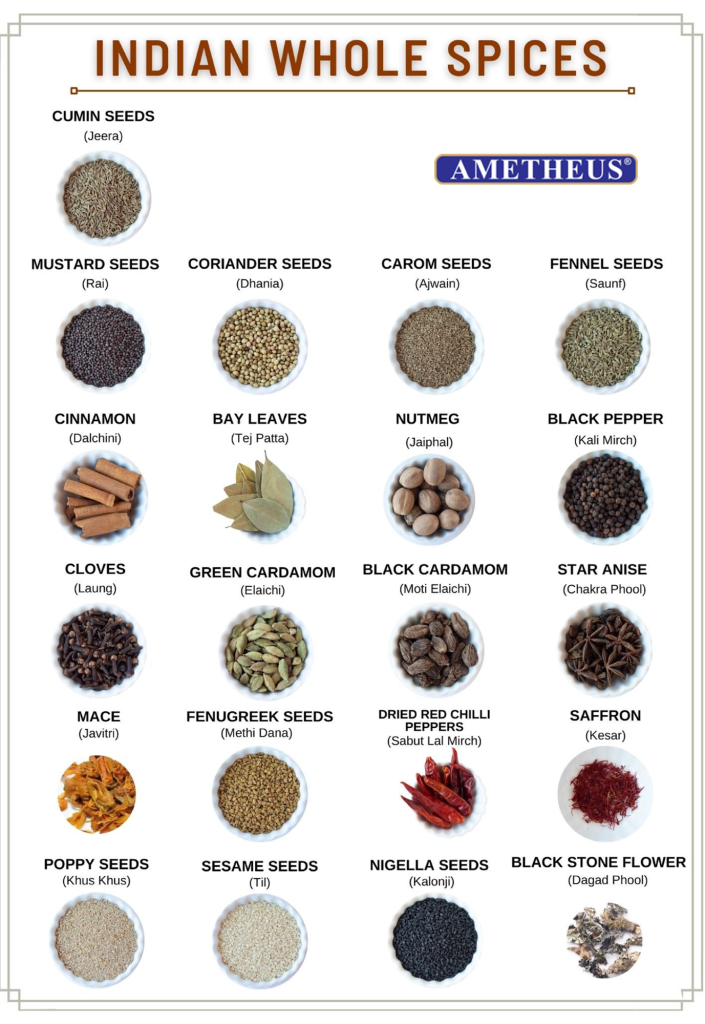
Cumin Seeds (Jeera)

Cumin is an herb that many associate with Mexican and Spanish foods, but it is also widely used in Middle Eastern and Indian cooking.
It is one ingredient I use when preparing most Indian style lentils and curries. In North India, cumin seeds are one of the first ingredient added to hot oil and we add the other ingredients after they splutter.
Mustard Seeds (Rai)

While cumin seeds are most commonly used in North India, mustard seeds are most used in South Indian cooking for tempering. Mustard seeds
come in a range of colors from yellow, brown and black.
In Indian cooking, we mostly use black mustard seeds. They add a crunch and flavor to the dish. Mustard seeds are added when tempering or making tadka.
A lot of South Indian recipes begin with adding these seeds in hot oil and waiting for them to pop before adding other ingredients.
Coriander Seeds (Dhania)

Coriander seeds are the dried fruit of the cilantro plant. They can be found as seeds or in ground form. It does not make a dish spicy, but adds a lot of flavor and aroma to it.
I usually buy coriander seeds and grind them myself, to have a fresher taste and also makes sure that it is not adulterated. But you don’t have to make it fresh everyday, just grind it and store for a few months.
Carom Seeds (Ajwain)

Ajwain has a aroma similar to thyme, but is more aromatic and less subtle in taste, as well as slightly bitter and pungent. A small number of seeds tend to dominate the flavor of a dish.
Ajwain is also used as a medicinal plant in traditional Ayurvedic medicine; primarily for stomach disorders such as indigestion. When growing up, if we had a stomach ache, having a teaspoon ajwain with water was the quick solution.
Fennel Seeds (Saunf)

Fennel is a flowering plant species in the carrot family. It is a highly aromatic and flavorful herb with culinary and medicinal uses. Dried fennel seeds are brown or green in color when fresh.
Fennel seeds are used in cooking or consumed as mukhwas, an after meal digestive and breath freshener. Fennel is also used as a flavoring in some natural toothpastes.
Cinnamon (Dalchini)

Cinnamon is used in both sweet and savory foods. It is commonly used for sweet foods all over the world, but in Indian cooking cinnamon is also used for savory foods.
The flavor of cinnamon is due to an aromatic essential oil that makes up 0.5 to 1% of its composition. Cinnamon is sautéd in oil for many Indian dishes. It is also a main ingredient for Garam Masala.
Bay Leaves (Tej Patta)

Bay leaves are commonly used in Indian cooking. Their flavor and fragrance is similar to the cinnamon bark but slightly milder.
Bay leaves are often used in rice dishes such as biryani/pulao and in soups. Just one to two bay leaves are enough to flavor an entire dish.
Nutmeg (Jaiphal)

Nutmeg, also known as Jaiphal in Hindi, is a magical Indian spice. Nutmeg is a well-known spice derived from the seeds of Myristica fragrans.
Nutmeg has a woody, bittersweet flavor with hints of clove. It has a rich flavor that is warm and nutty. It is commonly used in baking, desserts, curries and chai masala. It can used as a powder or you can shave the spice with a sharp knife or grater.
Black Pepper (Kali Mirch)

Black Pepper or Peppercorn is used frequently in Indian and Western cooking. It is the worlds most traded spice. It is often used as a seasoning, along with salt.
In Indian cooking, black peppercorns are also used to add aroma, flavor and heat to many dishes. You will find it commonly used in south Indian dishes such as upma or pongal.
Pepper loses flavor and aroma through evaporation, so airtight storage helps preserve its spiciness longer. Some dishes call for whole pepper, while other for ground pepper. I usually prefer to freshly grind pepper when needed.
Cloves (Laung)

Cloves are used in Asian, African and Middle eastern cuisines. In Indian foods, they are primarily used in meats and curries. They are also used in adding aroma to hot beverages blends.
Similar to cinnamon, cloves are sautéd in oil for many dishes, and are also an ingredient of garam masala.
Green Cardamom (Elaichi)

Green Cardamom is the world’s third-most expensive spice, surpassed in price per weight only by vanilla and saffron. Cardamom is used as a flavoring and cooking spice in both food and drink, and also as a medicine.
It is best stored in the pod as exposed or ground seeds quickly lose their flavor. When adding this to a savory dish, I just open the pods and add them to the oil initially along with other whole spices such as cloves. Elaichi is also commonly added to Indian tea or chai.
Black Cardamom (Moti Elaichi)

Black cardamom is dried over an open fire, which is what gives it such a powerful smokey aroma. The pods are used as a spice, in a similar manner to the green Indian cardamom pods, but have a different flavor profile.
This spice, unlike green cardamom, is rarely used in sweet dishes. Black cardamom is commonly used in the preparation of meats, biryanis, and garam masala. Just 1-2 pods are enough to get the flavor in a dish.
Star Anise (Chakra Phool)

Star Anise is commonly used in Chinese cuisine. It is used in Indian foods as well, such as biryani and meats, and to prepare garam masala.
Mace (Javitri)

Mace is the crimson or bright red colored spice or condiment, present as the second membrane covering the seed of the nutmeg fruit. Its taste is milder than that of nutmeg and is used in recipes which are delicately flavored.
Mace should be added at the beginning of cooking in order to develop its full flavor. In simple dishes like broth, soups, mashed potatoes, and rice dishes like biryani, mace is frequently used. Additionally, it is used in baked goods like pies, custard, puddings, muffins, cakes, and breads that are sweet.
Fenugreek Seeds (Methi Dana)

Fenugreek seeds have a slightly bitter flavor, similar to celery, and are frequently used in medicine. However, fenugreek has a far more pleasant taste when cooked.
The seeds are the most widely used part of fenugreek, which are usually dried and ground. Just a small amount is enough to flavor an entire dish. It is used in sambhar and people also use it to make chutney. I usually add fenugreek seeds when preparing idli/dosa batter.
Dried Red Chilli Peppers (Sabut Lal Mirch)

Kashimiri Red chili powder adds heat to a dish. This is preferred variety of chili, as it adds a distinct red color to the dish along with the spice. Red chili is usually added after most ingredients are added. Some dishes call for whole red chilies, while most others for the ground powder.
Similar to the coriander powder, I prefer to grind red chili powder myself. Just add the whole red chilies into the grinder and grind to a fine powder. Again, you can store and use this powder for few months.
Saffron (Kesar)

Saffron threads are collected and dried to be used as a seasoning and coloring agent in food. Saffron is the world’s most expensive spice by weight. Each strand is hand harvested from the stigma of a crocus that can only grow in certain climates.
Saffron can be used in savory preparations or sweet ones. In Indian cuisine, saffron is usually used in sweets like kheer or exotic dishes such as biryani.
Saffron threads are soaked in warm water or milk for several minutes prior to using it in a dish. This helps release the aromatic components of saffron.
Poppy Seeds (Khus Khus)

Poppy seeds or Khus Khus is an oilseed obtained from the poppy flower. The center of origin of Poppy is the Western Mediterranean region of Europe and is widely cultivated in India, Russia, Egypt, and many other countries. These are very tiny seeds, much smaller in size than mustard and are both dull white and black in color.
Poppy seeds are used in a variety of cuisines around the world to add a rich nutty flavor to dishes. These are Soaked in warm water or milk for two hours and then ground with other spices and used to thicken gravies. It gives a nutty, sweet flavor.
Sesame Seeds (Til)

Sesame seeds or Til are available in two varieties: white and black, each from a different variety of sesame plant. The white ones taste nutty, but the black seeds have an earthier flavor. Sesame oil is also widely used. The seeds are usually dry roasted to bring out their full flavor.
They are used in tempering like in this dhokla recipe. Sesame seeds are a rich source of calcium. They are very popular in India during winters as it is know to provide warmth to the body.
Nigella Seeds (Kalonji)

Nigella seeds also known as Kalonji or kala jeera in India. These have a strong aroma and a distinct flavor profile that includes notes of onion, cumin and oregano. These are widely used in Indian and Middle Eastern cuisine as a spice and condiment. It is one of the ingredients in the ”Panch Phoron” spice blend.
These flavorful seeds can be used to season curries and lentil dishes, as well as root vegetable dishes and stir-fries. Nigella seeds can also be sprinkled over naan bread before it is put in the tandoor. It is also added in making Indian pickle, Achaar. [Buy on Amazon]
Black Stone Flower (Dagad Phool)

The black stone flower is a lesser-known Indian spice that is popular on India’s west coast and in the Southern part of India. It is a lichen species that is commonly referred to as dagad phool in Marathi. Dagad Phool grows all year and the whole plant is used for medicinal and culinary purposes.
This has a greenish mineral grey hue (yellowish-white on top and black on the bottom) that gives various masalas such as Goda Masala/Kala Masala their signature black color.
Ground Spices : Here are the most popular ground spices used in Indian cooking.
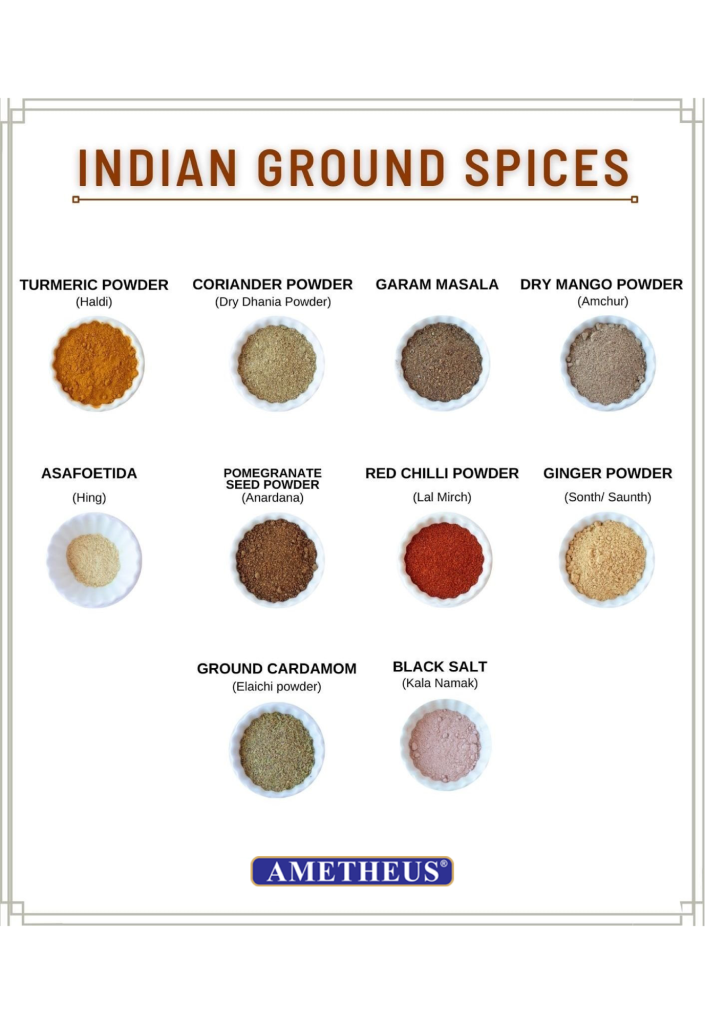
Turmeric Powder (Haldi)

Turmeric has a distinctive yellow color, and an earthy rich flavor. It is also called the wonder spice, due to it’s antioxidant and antiseptic properties.
Turmeric root is dried and then ground to a fine powder. It adds the yellow color to many savory Indian dishes and curries. It is usually added during the cooking process.
Coriander Powder (Dry Dhania Powder)

Coriander Powder, also called Dhaniya Powder is a must have spice for every Indian kitchen. Ground coriander is made from freshly roasted coriander seeds. It has a different flavor profile from coriander seeds.
While coriander seeds can be stored for a longer time, ground coriander is best when stored in small batches. It is used in curries, lentils, Indian stir-frys.
Red Chilli Powder (Lal Mirch)

Red chili powder is commonly used in marinades, curries, lentils and dry preparations for both heat and color. Typically, fresh chilli is used during the cooking process, with additional chili powder added if more heat is desired.
This powder is made up by grinding dried red chillies. I like to make mine at home by grinding small batches and this is free of additives.
Garam Masala
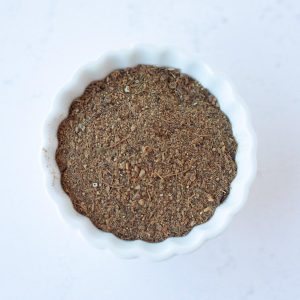
Garam masala is a blend of ground spices commonly used in Indian and Pakistani food. The word garam refers to “heating the body” in the Ayurvedic sense of the word, as these spices are believed to elevate body temperature in Ayurvedic medicine.
Typical ingredients for garam masala include: black peppercorns, cinnamon, cloves, black cardamom, nutmeg, and green cardamom. You can use my recipe to make your own Garam masala at home.
Dry Mango Powder (Amchur)

Amchur or Amchoor is a powder of sun dried raw mangoes. It is used for it’s tangy fruity flavor in Indian cuisine. It has an earthy component along with the sour taste. It is predominantly used in North Indian dishes.
Asafoetida (Hing)

Asafoetida is used in Indian foods such as lentils and curries, added when tempering or adding tadka. In its raw form, asafoetida has a fetid odor, but it delivers a smooth flavor reminiscent of leeks, when used in cooked foods.
Pomegranate Seed Powder (Anardana)

Pomegranate seed powder (Anardana) are dried and used in Indian (primarily Punjabi) and Persian cuisine. The seeds are procured from a wild, sour variety of pomegranate, and not the sweeter pomegranate that we eat commonly.
The seeds are used to flavor chutneys, vegetables, and legume dishes with a sweetish-sour flavor. Some lamb dishes include the whole seeds.
Typically, the seeds are crushed or ground in a mortar and pestle before use, but depending on the recipe, the seeds can be used whole. The seeds are also available ground as a powder, but grinding your own gives you better flavor.
Black Salt (Kala Namak)

Indian Black salt (also known as Himalayan black salt) is a volcanic rock salt found in the Himalayas and Northern India. The salt appears dark grey when solidified. When pulverised, however, it takes on a pinkish color.
The sulfuric compounds in kala namak contribute to its tangy and pungent flavor. In the kitchen, this serves as an umami-rich flavor enhancer.
Most notably, it’s a key ingredient in chaat masala, and is used for Indian chaats. Many people use it to enhance the savoury notes in chutneys, achars, and raitas. It tastes great when added to Indian lemonade.
Ginger Powder (Sonth/ Saunth)
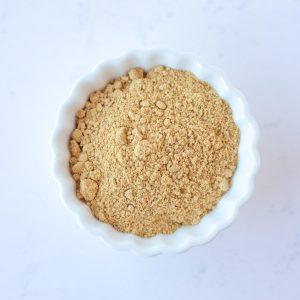
This dried ginger powder is made by drying and powdering fresh ginger roots. A high-quality ginger powder is light in colour, with a sharp flavor and a sweet aroma.
It is used in a variety of dishes, including curries, pickles, and homemade relishes. With its multiple culinary applications, sonth is an excellent remedy for a variety of health problems.
Ground Cardamom (Elaichi powder)
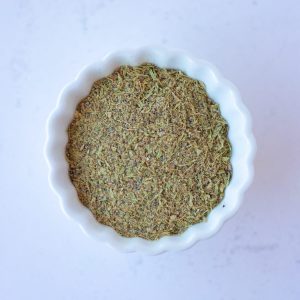
Ground cardamom powder is an aromatic ground spice that enhances the aroma of Indian dishes like pulao, biryani and desserts like gulab jamun, shrikhand etc . It is also an integral part of Thandai Masala, a blend used to prepare a milk based drink called Thandai.
It is made by grinding the seeds of the green cardamom pods. It is especially useful as it can be sprinkled over dishes during or after cooking, saving you the time-consuming process of breaking open the pods and grinding the seeds.
Indian Herbs : Below are the commonly used herbs in Indian cooking.
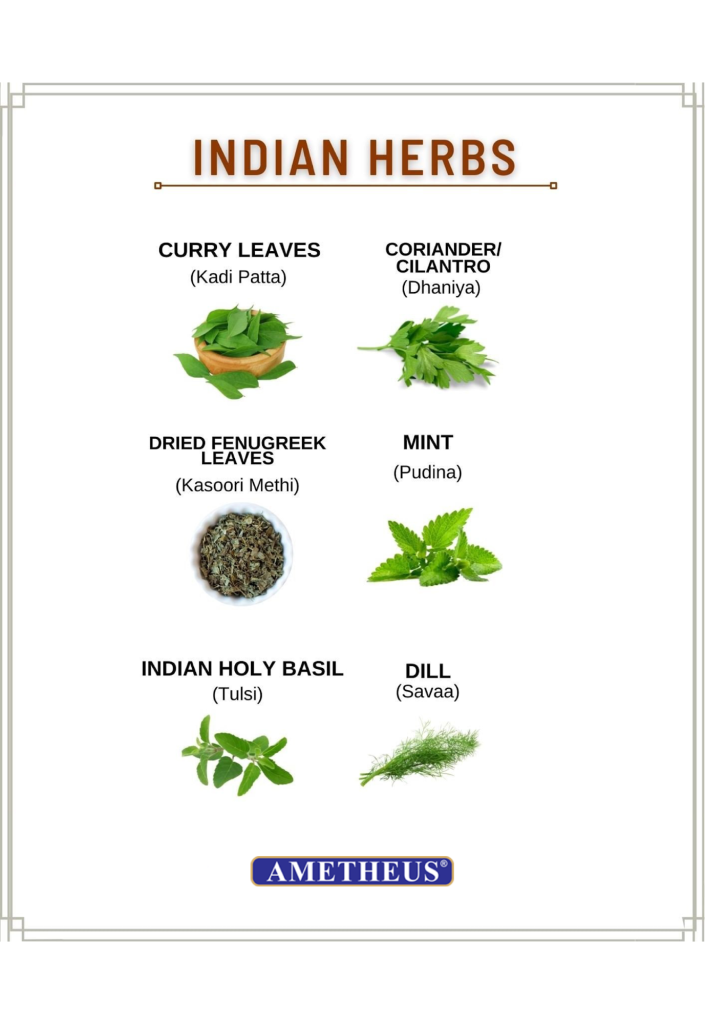
Curry Leaves (Kadi Patta)
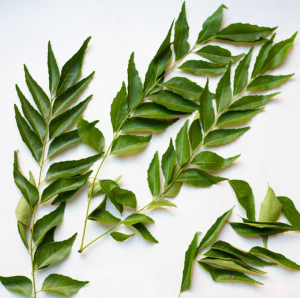
Curry leaves are aromatic leaves commonly used in South Indian cuisine. We usually find fresh leaves in Indian grocery stores or people also grow this plant in a small pot.
They are also referred to as ‘sweet neem leaves’ because they resemble neem leaves but are darker in colour and less bitter.
In South India, a handful of curry leaves added during tempering adds a distinct flavor to curries and gravies. Here is my post about how to buy, use and store fresh curry leaves.
You can also use curry leaves to make chutneys and spice powders to serve with rice. But if you don’t have access to fresh leaves, you can buy dried curry leaves. They are usually added as one of the first things to the oil along with mustard seeds.
Dried Fenugreek Leaves (Kasoori Methi)

Fenugreek is used as an herb (dried or fresh leaves) or as a spice (seeds). Kasoori methi are dried leaves of the fenugreek plant . They are used in Indian cooking and taste similar to a combination of celery and fennel with a slightly bitter bite.
Typically the leaves are crumbled and sprinkled over meat and vegetable curries before serving. I frequently add them to butter chicken or paneer dishes. Kasoori methi can also be added to whole wheat dough to make methi roti or paratha.
Mint (Pudina)
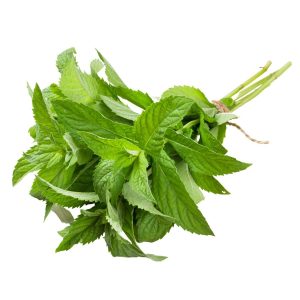
Mint commonly known as Pudina in India, is an essential ingredient in cooking, especially during the summer. Indian mint has a more robust flavor and aroma than Western varieties.
Mint is sweet and strong, with hints of a sharp lemony flavor. Mint’s warm, sweet fragrance is refreshing to the palate, leaving a clean aftertaste. It is a versatile herb and can be used as as fresh leaves, paste or dried powder.
It is widely used in Indian cooking in chutneys, salads, sauces, raitas and teas. Mint is commonly used in biryanis and lassi. I sun dry fresh mint leaves so they can be stored and used as required.
Indian Holy Basil (Tulsi)
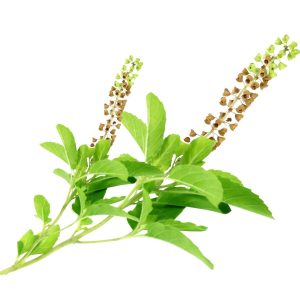
Tulsi or Holy basil is a green leafy herb with strong aromatic qualities. Because it contains essential oils, it is used as a herbal remedy for a variety of common ailments.
It is consumed as a herbal tea. It is also used in the preparation of Thai curries. It is also used to make Panchamrut, which has five main components: milk, yogurt (dahi), ghee, honey, tulsi (Indian holy basil).
Coriander leaves / Cilantro (Dhaniya)
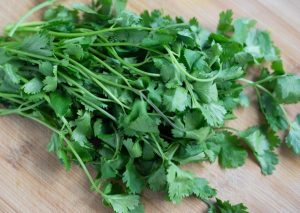
Coriander is a native plant found all over the world. The plant’s leaves are commonly also known as cilantro, which is derived from the Spanish word for coriander, or Chinese parsley.
Fresh cilantro tastes pungent and some people also find it soapy. Fresh coriander leaves are used as a garnish in Indian curries, soups and stir fries. It is also used to make chutney. You can buy it at any grocery store.
Dill (Savaa)
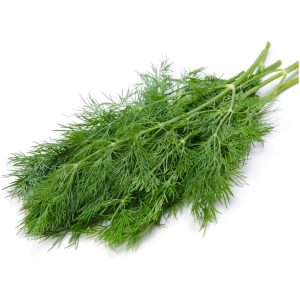
Fresh dill leaves, also known as dill weed, can be used as a flavor enhancer in the same way that cilantro is.

